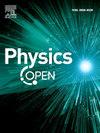采用CNN、DNN和AE机器学习算法的高阶调制光学OTFS波形PAPR分析
IF 1.4
Q2 Physics and Astronomy
引用次数: 0
摘要
光正交时频空间(OTFS)调制是一种未来的高移动性光无线通信技术。然而,OTFS调制的高峰值平均功率比(PAPR)严重降低了系统性能,特别是在高阶调制格式的情况下。本文提出了一种基于机器学习(ML)的PAPR降低算法,用于不同信道条件下的光学OTFS,如湍流和多径衰落。该方法利用深度学习模型最大化信号处理和抑制峰值功率变化,同时保证信号完整性。仿真结果表明,在互补累积分布函数(CCDF)为10-5的条件下,该方法对256-QAM的PAPR降低了约4 dB和3.8 dB,对64-QAM的PAPR降低了约2.2 dB和1.6 dB,优于传统的PAPR降低方法。功率谱密度(PSD)分析验证了基于ml的技术,如深度神经网络(DNN)、卷积神经网络(CNN)和自动编码器(AE),对于不同信道条件下的256QAM具有频谱效率,可以忽略-1070和-1470的带外辐射。此外,误码率(BER)性能测试表明,在误码率为10-5的情况下,信噪比提高了8.2 dB,信噪比提高了3.9,保证了各种移动场景下的无差错数据传输。此外,将所提出的方法与部分传输方案(PTS)、选择性映射方案(SLM)、音调保留方案(TR)、压缩、裁剪和滤波方案(C&;F)进行了比较。数值结果强调了机器学习在没有PSD和误码率的情况下提高PAPR性能的能力。这一结果对未来的光纤无线网络具有重要意义,在那里必须保持高数据速率并最小化非线性失真。本文章由计算机程序翻译,如有差异,请以英文原文为准。
Optical OTFS waveform PAPR analysis for high order modulation employing CNN, DNN, and AE machine learning algorithms under a variety of channel scenarios
Optical orthogonal time–frequency space (OTFS) modulation is a future technique for optical wireless communication with high mobility. Nevertheless, the high peak-to-average power ratio (PAPR) of OTFS modulation severely degrades the system performance, particularly in the case of high-order modulation formats. This paper proposes an algorithm for machine-learning (ML)-based PAPR reduction dedicated to optical OTFS under varying channel conditions, such as turbulence and multipath fading. The proposed method utilizes deep learning models to maximize signal processing and suppress peak-power variations, while ensuring signal integrity. The simulations result prove that the proposed method attains a PAPR reduction of about 4 dB and 3.8 dB for 256-QAM and 2.2 dB and 1.6 dB for 64-QAM under a Rayleigh and Rician channel at a Complementary Cumulative Distribution Function (CCDF) of 10-5, better than conventional PAPR reduction methods. Power Spectral Density (PSD) analysis verifies that ML-based techniques, such as deep neural networks (DNN), convolutional neural networks (CNN), and autoencoders (AE), are spectrally efficient with negligible out-of-band radiation of -1070 and -1470 for 256QAM with diverse channel conditions. Moreover, Bit Error Rate (BER) performance tests demonstrate an SNR improvement of 8.2 dB and 3.9 at a BER of 10-5, guaranteeing error-free data transmission for diverse mobility scenarios. Furthermore, the proposed methods are compared with partial transmission schemes (PTS), selective mapping (SLM), tone reservation (TR), companding, clipping, and filtering (C&F). The numerical results emphasize the capability of ML to improve PAPR performance without PSD and BER performance. The results are significant for future optical wireless networks, where high data rates must be sustained and nonlinear distortion minimized.
求助全文
通过发布文献求助,成功后即可免费获取论文全文。
去求助
来源期刊

Physics Open
Physics and Astronomy-Physics and Astronomy (all)
CiteScore
3.20
自引率
0.00%
发文量
19
审稿时长
9 weeks
 求助内容:
求助内容: 应助结果提醒方式:
应助结果提醒方式:


